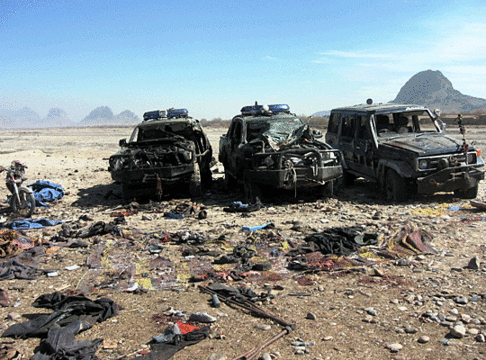|
|
|
Aftermath of the suicide attack in Kandahar province. |
A Taliban suicide bomber detonated himself among a densely packed crowd in southern Afghanistan during a dog fighting match, killing at least 55 people and injuring 80 others. Local Kandahar health officials have counted 70 dead bodies, and claim families took away other dead bodies from the scene for a traditional quick burial making a final death toll unknown, according to an NPR report.
The intended target of the attack appears to be Abdul Hakim Jan, an anti-Taliban militia leader, who was in attendance at the event. Jan was recently appointed as the leader of the auxiliary police force in the contested Arghandab district of Kandahar province. He opposed the Taliban in the early 1990s when he served as Kandahar’s provincial police chief. Witnesses say the bomber came within 15 feet of Jan before detonating. Investigators have so far failed to find Jan’s remains but have presumed him to be dead.
Dog fighting was banned under the Taliban regime but has since made a comeback throughout southern Afghanistan. Locals say that Jan attended the event to watch one of his dogs participate in the fight and that a large number of spectators, including other anti-Taliban militia leaders, had turned out for the match. The attacker was able to mingle into the crowd and slowly approached Jan’s entourage before pulling the plunger on his bomb-laden vest. Body parts, bloodied clothing, and debris littered the arena following the blast while police and Afghan soldiers secured the site and rushed the injured to a Kandahar hospital. At least three burned-out police trucks could be seen smoldering hours after the blast had occurred. Afghan officials have since denounced the attack. Kandahar governor Asadullah Khalid blamed the “enemies of Afghanistan,” a term usually used to describe the Taliban.
This is the second deadliest suicide attack in Afghan history; only the suicide bombing at a northern Baghlan sugar factory last November surpasses it in the number killed. At least 75 people died in the Baghlan attack, six of the dead were parliamentarians and the rest were mostly school children and teachers. Bodyguards in charge of protecting the parliamentarians opened fired on the crowd shortly after the attack causing additional casualties, but how many were caused by the gunfire was never disclosed by Afghan investigators.
Sunday’s attack in Kandahar is the latest string of assassination attempts conducted by Taliban fighters aimed at government officials and supporters.
On Feb. 11, Kandahar governor Asadullah Khalid survived a roadside bomb attack that blew through his convoy while he traveled to the Arghandab district to attend a security meeting between locals and Canadian forces. The bombing left three Afghan police escorts dead and destroyed their vehicle.
Late last month, Pir Mohammad, the deputy governor of neighboring Helmand province, was killed along with five others after a suicide bomber detonated inside the mosque they were praying in.
In March 2007, Mullah Naqib, an influential anti-Taliban cleric and Alokozai tribal elder, was nearly killed when a Taliban planted roadside bomb exploded beneath his armored vehicle in Arghandab. Naqib’s son and one of his bodyguards died the attack.
In October 2005, another suicide bomber attacked the Kandahar home of Agha Shah, an anti-Taliban militia leader associated with the former Northern Alliance. Agha Shah died in the attack along with two civilians walking by his house at the time of the blast.
In June 2005, General Akram Khakrezwal, the newly appointed chief of police for Kabul, was killed in a suicide bombing along with 19 others during a funeral ceremony in Kandahar city. More that 50 others were wounded when the massive explosion tore through the entryway to the mosque during the crowded memorial service.
The Arghandab district has been a flashpoint since the death of Mullah Naqib in early October 2007. The district is a key buffer zone between the urban areas of Kandahar under government control and the Taliban-infiltrated districts to the north of Kandahar City.
The Taliban made a push to attack Kandahar’s provincial capital late last year, using Arghandab as a base of operations. The Taliban overran Arghandab in late October, and Afghan and Canadian troops recaptured the district by Nov. 1. The Canadians started construction of a forward operating base in the district in mid-December 2007 to establish a firm presence in the area.
Bill Roggio contributed to this report.









7 Comments
Acts of desperation??
How can the taliban do such a terrible act without turning the people against tgenselfs?? Can someone explain what´s the meaning?
Helge
Abdul Hakim Jan – Cop, Alokozai Arbakai, Militia Chief
A man of many talents. I suspect his loss will be felt.
Maybe this year’s Great Spring Offensive won’t be such a farce, especially if they cut the LOC.
Do LAV III’s burn diesel or JP-8?
LAV-III has a 350 hp Caterpillar diesel engine
Revenge for killing Al-Libi and capturing Mansoor?…….
Re: Mansoor — I assume that depends on the details of who turned him in…
VBIED at Spin Boldak Kills 37 Afghans, Wounds 3 Canadians
The Taliban get away with it because there are so many people there that can’t read or write and must rely on what others tell them. Unfortunately alot of times those sources of information are Pro Taliban.